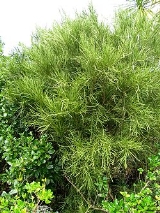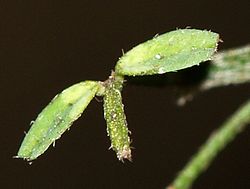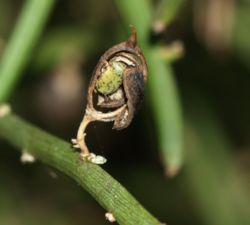
New Zealand Broom
Encyclopedia


Fabaceae
The Fabaceae or Leguminosae, commonly known as the legume, pea, or bean family, is a large and economically important family of flowering plants. The group is the third largest land plant family, behind only the Orchidaceae and Asteraceae, with 730 genera and over 19,400 species...
, the legume family. All but one species are native to New Zealand
New Zealand
New Zealand is an island country in the south-western Pacific Ocean comprising two main landmasses and numerous smaller islands. The country is situated some east of Australia across the Tasman Sea, and roughly south of the Pacific island nations of New Caledonia, Fiji, and Tonga...
. The exception, Carmichaelia exsul, is native to Lord Howe Island
Lord Howe Island
Lord Howe Island is an irregularly crescent-shaped volcanic remnant in the Tasman Sea between Australia and New Zealand, directly east of mainland Port Macquarie, and about from Norfolk Island. The island is about 11 km long and between 2.8 km and 0.6 km wide with an area of...
and must have dispersed from New Zealand.
The formerly recognised genera of Chordospartium, Corallospartium, Notospartium, and Huttonella are now included in Carmichaelia. The Carmichaelia, Clianthus (kakabeak), Montigena (scree pea) and Swainsona
Swainsona
Swainsona is a large genus of flowering plants native to Australasia. There are 85 species, all but one of which is endemic to Australia; the exception, S...
genera comprise the clade Carmichaelinae.
Carmichaelia have a range of forms from trees to prostrate species a few centimetres high. Mature plants are usually leafless, with stipule
Stipule
In botany, stipule is a term coined by Linnaeus which refers to outgrowths borne on either side of the base of a leafstalk...
s fusing into scales to replace leaves.
Carmichaelia is named after Captain Dugald Carmichael
Dugald Carmichael
Dugald Carmichael was a Scottish botanist and officer in the 72nd Highlanders. He is known as the "Father of Marine Botany". The plant genus Carmichaelia is named after him.He was a friend of Sir William Hooker.-References:...
, a Scottish army officer and botanist who studied New Zealand plants.
Carmichaelia is distributed throughout New Zealand although the eastern South Island
South Island
The South Island is the larger of the two major islands of New Zealand, the other being the more populous North Island. It is bordered to the north by Cook Strait, to the west by the Tasman Sea, to the south and east by the Pacific Ocean...
has 15 species endemic to it. Most species have a restricted range within New Zealand. They colonise disturbed ground in shallow, poor soils, drought- and frost-prone areas and alluvial soils.
New Zealand Broom is not closely related to the European species Cytisus scoparius
Cytisus scoparius
Cytisus scoparius, the Common Broom and Scotch Broom, syn. Sarothamnus scoparius, is a perennial leguminous shrub native to western and central Europe,....
, Common Broom, which has been introduced to New Zealand, where it is commonly known as Scotch Broom and is classed as a noxious weed
Weed
A weed in a general sense is a plant that is considered by the user of the term to be a nuisance, and normally applied to unwanted plants in human-controlled settings, especially farm fields and gardens, but also lawns, parks, woods, and other areas. More specifically, the term is often used to...
because of its invasiveness.
Species
Species having the cylindrical shaped leaves typically found in northern hemisphere broomsBroom (shrub)
Brooms are a group of evergreen, semi-evergreen, and deciduous shrubs in the subfamily Faboideae of the legume family Fabaceae, mainly in the three genera Chamaecytisus, Cytisus and Genista, but also in many other small genera . All genera in this group are from the tribe Genisteae...
:
- Carmichaelia stevensonii: Weeping broom or Tree broom is a distinct tree, growing up to 9 m high. It occurs only at altitude in the northeast corner of the South IslandSouth IslandThe South Island is the larger of the two major islands of New Zealand, the other being the more populous North Island. It is bordered to the north by Cook Strait, to the west by the Tasman Sea, to the south and east by the Pacific Ocean...
, particularly along the ClarenceClarence River, New ZealandClarence River is located on South Island of New Zealand. It is 160 kilometres long.For its first 50 kilometres, the river runs in a generally southeastern direction. It then turns northeast, running down a long straight valley between the Inland and Seaward Kaikoura Ranges...
and Awatere RiverAwatere RiverThe Awatere River is a large river flowing through Marlborough, New Zealand. Flowing along the trace of the active Awatere Fault, it runs northeast through a straight valley to the west of the Inland Kaikoura mountains...
s. - Carmichaelia glabrescens: Pink broom, grows up to 10 m high. It also is restricted to growing at altitude in the MarlboroughMarlborough, New ZealandMarlborough is one of the regions of New Zealand, located in the northeast of the South Island. Marlborough is a unitary authority, both a region and a district, and its council is located at Blenheim. Marlborough is known for its dry climate, the picturesque Marlborough Sounds, and sauvignon blanc...
region of the South Island.
Species where the green branches or branchlets are flattened and take the place of leaves. The mature specimens are almost completely leafless while the juvenile form may have a few leaves:
- Carmichaelia williamsii: Giant flowered broom. Found in coastal regions of the Bay of PlentyBay of PlentyThe Bay of Plenty , often abbreviated to BOP, is a region in the North Island of New Zealand situated around the body of water of the same name...
and East CapeEast CapeEast Cape is the easternmost point of the main islands of New Zealand. It is located to the north of Gisborne in the northeast of the North Island....
. - Carmichaelia grandiflora: Large flowered broom. Found only on the West CoastWest Coast, New ZealandThe West Coast is one of the administrative regions of New Zealand, located on the west coast of the South Island, and is one of the more remote and most sparsely populated areas of the country. It is made up of three districts: Buller, Grey and Westland...
of the South Island. - Carmichaelia arborea: South Island broom.
- Carmichaelia odorata: Scented broom.
- Carmichaelia aligera: North Island broom. Common throughout the northern part of the North IslandNorth IslandThe North Island is one of the two main islands of New Zealand, separated from the much less populous South Island by Cook Strait. The island is in area, making it the world's 14th-largest island...
. - Carmichaelia enysii: Dwarf broom. Forms low clumps not more than a few centimetres high. Found south of Arthur's PassArthur's PassArthur's Pass is a mountain pass in the Southern Alps of the South Island of New Zealand. It marks part of the boundary between the West Coast and Canterbury regions, 140 km from Christchurch and 95 km from Greymouth. The pass lies in a saddle between the valleys of the Otira River, a...
.
Other notable species include:
- Carmichaelia angustata: Leafy broom: very similar to the above species except that it usually has some leaves.
- Carmichaelia flagelliformis: Whip broom; the stems are rounded, thin and whippy. Found from the East Cape southwards.
- Carmichaelia crassicaule: Coral broom. Occurs in arid, stony ground on the eastern side of the Southern AlpsSouthern AlpsThe Southern Alps is a mountain range extending along much of the length of New Zealand's South Island, reaching its greatest elevations near the island's western side...
, growing up to an altitude of 1300 m.

